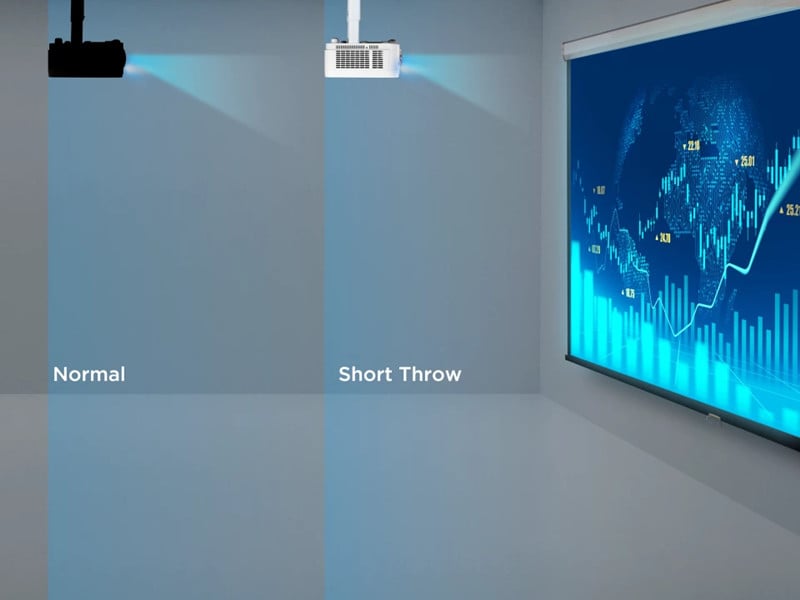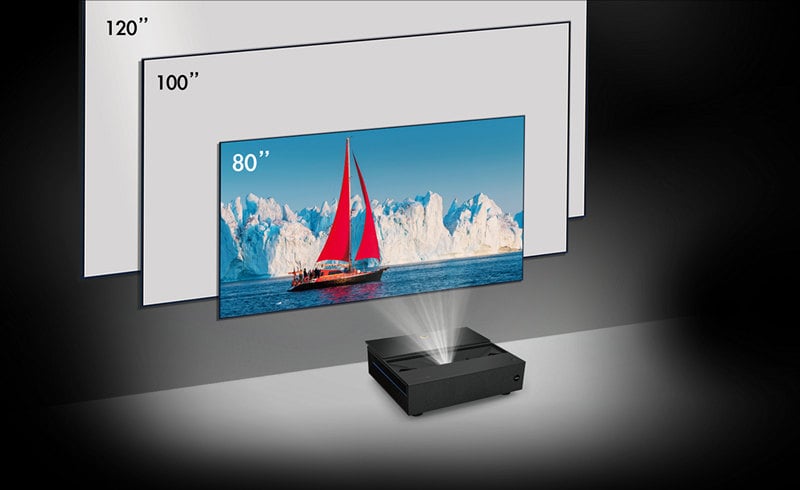Throw ratio is a key parameter when you choose a projector. In this guide, you can know all things about the projector throw ratio, including what is throw ratio and what does the throw ratio mean. In addition, the pros and cons of UST projector, buying guide on throw ratio, projector screen size and throw distance calculation methods, and common screen size dimensions will be explained detailedly.
What is Throw Ratio?
Throw ratio describes the ratio of throw distance and image width. That’s to say, Throw ratio= Throw Distance / Image Width. It indicates how big the screen size a projector can project under the same distance, or how short the throw distance a projector can achieve under the same screen size.

Provided the same image Width (the same screen size), the bigger the throw ratio, the longer the throw distance. In contrast, the smaller the throw ratio, the shorter the throw distance.
For example, if you have a projector with a throw ratio of 1.2:1, the projector screen size is 100 inches, then the throw distance will be 266.58cm. However, if the throw ratio is 0.39:1 and the screen size is the same 100 inches, the throw distance is just 86.64 cm.

Generally, a common projector has a throw ratio of 1-1.9.
What Does a Short Throw Ratio Mean?
A projector with a short throw ratio means that it can project a big screen size in a narrow room. If you prefer a big screen but your room is narrow, you can choose a projector with a short throw.

For example:
projector A has a throw ratio of 1.3:1 while projector B has a throw ratio of 0.39:1; presuming the screen size is 120 inches.
The throw distance of Projector A is 346.55 cm.
The throw distance of Projector B is 103.97 cm.

We can find that it requires 346.55 cm for Projector A to project a 120-ich screen while it needs only 103.97 cm for projector B.
What is Short Throw Projector?
Generally, we call a projector with a throw ratio of no more than 1 short throw projector. This kind of projector can project an 80 to 100 In screen within a throw distance range of 1m-1.5m.

Short throw projectors are widely used in commercial projectors, home projectors, and educational projectors, which presents large image within a short distance.
What is UST Projector?
UST refers to Ultra Short Throw projectors. Just like its name indicates, the UST projector has a throw ratio of no more than 0.4. You can just place a UST projector on a TV cabinet because it can project a big screen within a short throw distance.

Most UST projectors have high-end specifications, for example, a laser light source and 4K resolution, therefore the price is much more expensive compared with common projectors. UST projectors with a laser light source are known for laser TV.
There are many UST projectors in the market, for example, VAVA Chroma, Hisense PX1-PRO, BenQ V7050i, and XGIMI Aura.

Pros and Cons of the UST Projector
As a coin has two sides, a UST projector has its pros and cons accordingly. Most UST projectors cost more than $2,000. In addition, the max screen size is not big enough. The max screen size of a UST projector is 120-150 in.

Pros of UST Projector
- Convenient and easy setup.
- Take up less space in the room.
Cons of UST projector
- Expensive.
- The max screen is relatively small.
Projector Buying Guide: Throw Ratio
Just like we have talked about above, a UST projector is more expensive than a common projector. If you have a spacious room, you don’t necessarily buy a UST projector.
So, how to choose a projector with a proper throw ratio?
If you want to place your projector on a cabinet just like a TV, you can buy a UST projector.
If you want a big screen of 200In- 300In in your room, you can choose a short-throw projector.
If the budget is limited or the room is spacious enough, you can just pick a common projector.
| Types | UST projector (Throw Ratio<0.4) | Short Throw Projector (Throw Ratio<1) | Common Projector (Throw Ratio:1-1.9) |
| Pros | Take up the least space; Easy to set up; Biggest screen for the same throw distance | Take up less space; Bigger screen for the same throw distance | Cheap |
| Cons | Expensive The Max screen is limited | Relatively cheap | Take up more space Smaller screen for the same throw distance |
How to Calculate Screen size and Throw Distance?
To make sure that your projector matches your screen and your room well, you’d better calculate the screen size and throw distance beforehand.
Method 1: Online Projector Calculator
You can use an online projector calculator of projector1. Here are the detailed steps.
- Find the throw ratio of the projector that you want to buy.
- Select the throw ratio on the projector calculator.
- Input the screen size that you have bought or the screen size you want.
- Click the calculate button.
- Then you can know the corresponding throw distance.

If you input the throw distance, you can calculate the corresponding screen size.
You can also use the calculator to calculate the best viewing distance.
Method 2: Manual Calculation
You can calculate the screen size and throw distance by means of the equation Throw ratio= Throw Distance / Image Width.
Calculate Screen size
Image width =Throw distance/Throw ratio
After getting the result of image width, you can convert to screen size according to the common screen size dimensions table in the next section.
Calculate Throw distance:
Throw distance= Image Width ⅹ Throw Ratio
You can multiple the image width and throw ratio to get the throw distance.
Common Screen Size Dimensions
You can refer to the screen width and height before buying a projector screen.
| Screen Size (Inch) | Width x Height (mm) |
| 55 In | 1217.6mm x 685mm |
| 65 In | 1439mm x 809.5mm |
| 100 In | 2213.9mm x 2213.9mm |
| 110 In | 2435.3mm x 1369.9mm |
| 120 In | 2656.7mm x 1494.5mm |
| 150 In | 3320.9mm x 1868.1mm |
| 160 In | 3542.2mm x 1992.6mm |
| 180 In | 3985mm x 2241.7mm |
| 200 In | 4427.8mm x 2490.8mm |
| 250 In | 5534.8 mm x 3113.5 mm |
| 300 In | 6641.7 mm x 3736.2 mm |
That’s all for the guide of projector throw ratio. If you have any other problems with the throw ratio, you can leave us a message in the comment zone.
Related Posts
Projector Screen Complete Buying Guide 2022
Projector Buying Guide 2022
How Much Does a Projector Cost?
3LCD vs LCOS vs DLP Projector: Pros and Cons Introduction
How to Solve Black Spots Problem of Projector Screen?




